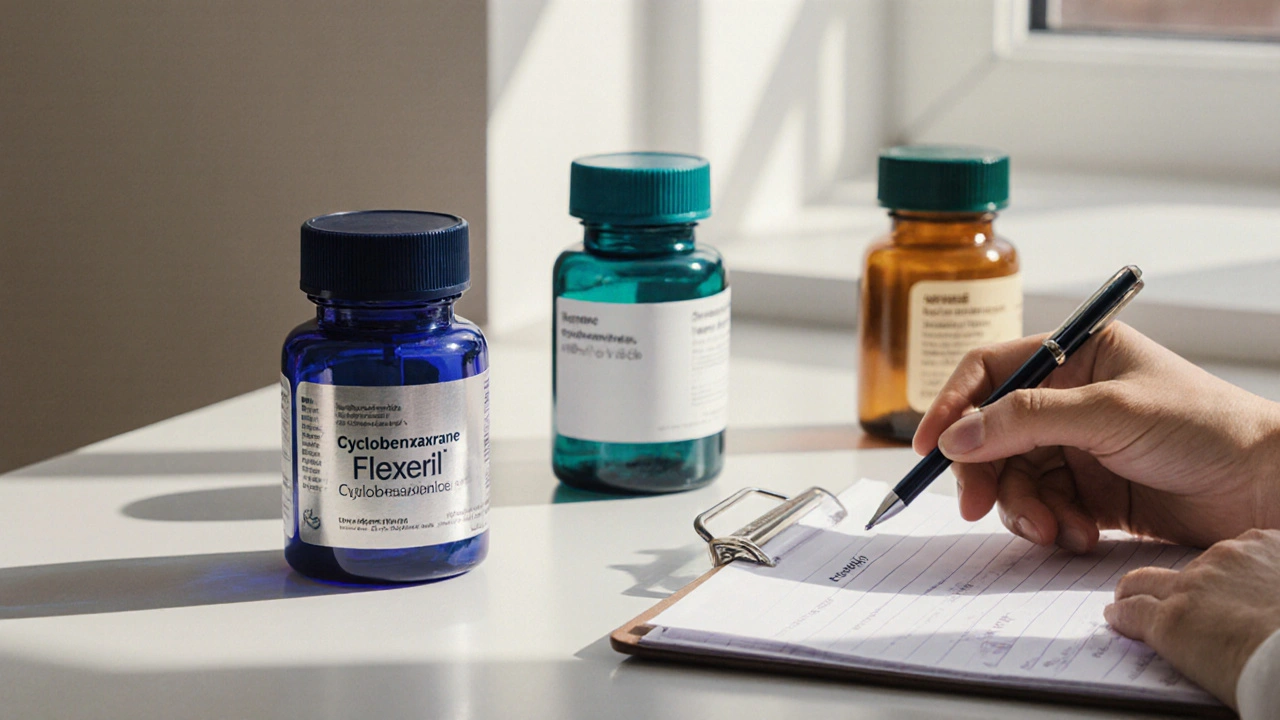Flexeril – What It Is, How It Works, and When to Use It
When working with Flexeril, the brand name for the muscle‑relaxant cyclobenzaprine. Also known as cyclobenzaprine, it’s prescribed to ease muscle spasms, involuntary contractions of skeletal muscles that cause pain and limit movement. Flexeril belongs to the tricyclic‑antidepressant family, but its main job is to block nerve signals that fire too often during a spasm. The drug is meant for short‑term use—usually two to three weeks—because the body can build tolerance and side‑effects tend to rise over time. A typical adult dose starts at 5 mg three times a day, possibly rising to 10 mg, but doctors adjust it based on age, liver function, and other meds. Because it can make you drowsy, many patients are told not to drive or operate heavy machinery until they know how it affects them. In short, Flexeril treats muscle spasms, requires a prescription, and should be part of a broader pain‑management plan that considers duration, dosage, and overall health.Flexeril is often the first line when over‑the‑counter painkillers aren’t enough.
Safety, Interactions, and Alternative Approaches
One of the biggest challenges with Flexeril is its interaction profile. It can amplify the effects of other central nervous system depressants—like alcohol, benzodiazepines, or antihistamines—leading to excessive sedation or even respiratory issues. Combining it with monoamine‑oxidase inhibitors (MAOIs) or certain antidepressants can raise the risk of serotonin syndrome, a potentially life‑threatening condition. Kidney or liver impairment also slows the drug’s clearance, so dose cuts are essential. Common side‑effects include dry mouth, dizziness, and constipation; a minority experience more serious heart rhythm changes, especially at higher doses. Because of these risks, many clinicians recommend adjunct therapies that don’t carry the same systemic load. Physical therapy, targeted exercises and manual techniques that improve muscle strength and flexibility can reduce the frequency of spasms and shorten the need for medication. Over‑the‑counter NSAIDs like ibuprofen address inflammation that sometimes triggers spasms, while heat or cold packs provide immediate relief without drug exposure. For patients interested in holistic routes, acupuncture and certain herbal supplements have shown modest benefits in small studies, but they should never replace a prescribed regimen without a doctor’s okay. The key is a balanced plan: Flexeril handles acute flare‑ups, while non‑pharmacologic options keep the muscles stable in the long run.
The articles you’ll see below pull together real‑world tips from a variety of health topics that intersect with Flexeril use. Whether you’re looking at lifestyle changes for low libido, coping strategies for osteoporosis‑related mood shifts, or safe ways to buy generic medications online, each post adds a piece to the puzzle of managing pain, medication safety, and overall wellness. You’ll find practical advice on drug comparisons—like how generic Abilify stacks up against brand versions—plus deeper dives into conditions that often coexist with muscle issues, such as chronic back pain, stress‑related tension, and even mental‑health impacts. By reading through the collection, you’ll get a clearer picture of how Flexeril fits into a comprehensive health strategy, what red‑flags to watch for, and which alternative therapies might complement your treatment plan.
Flexeril vs. Other Muscle Relaxants: Full Comparison
A detailed comparison of Flexeril (Cyclobenzaprine) with top muscle‑relaxant alternatives, covering effectiveness, side effects, costs, and best‑use scenarios.
Read more
